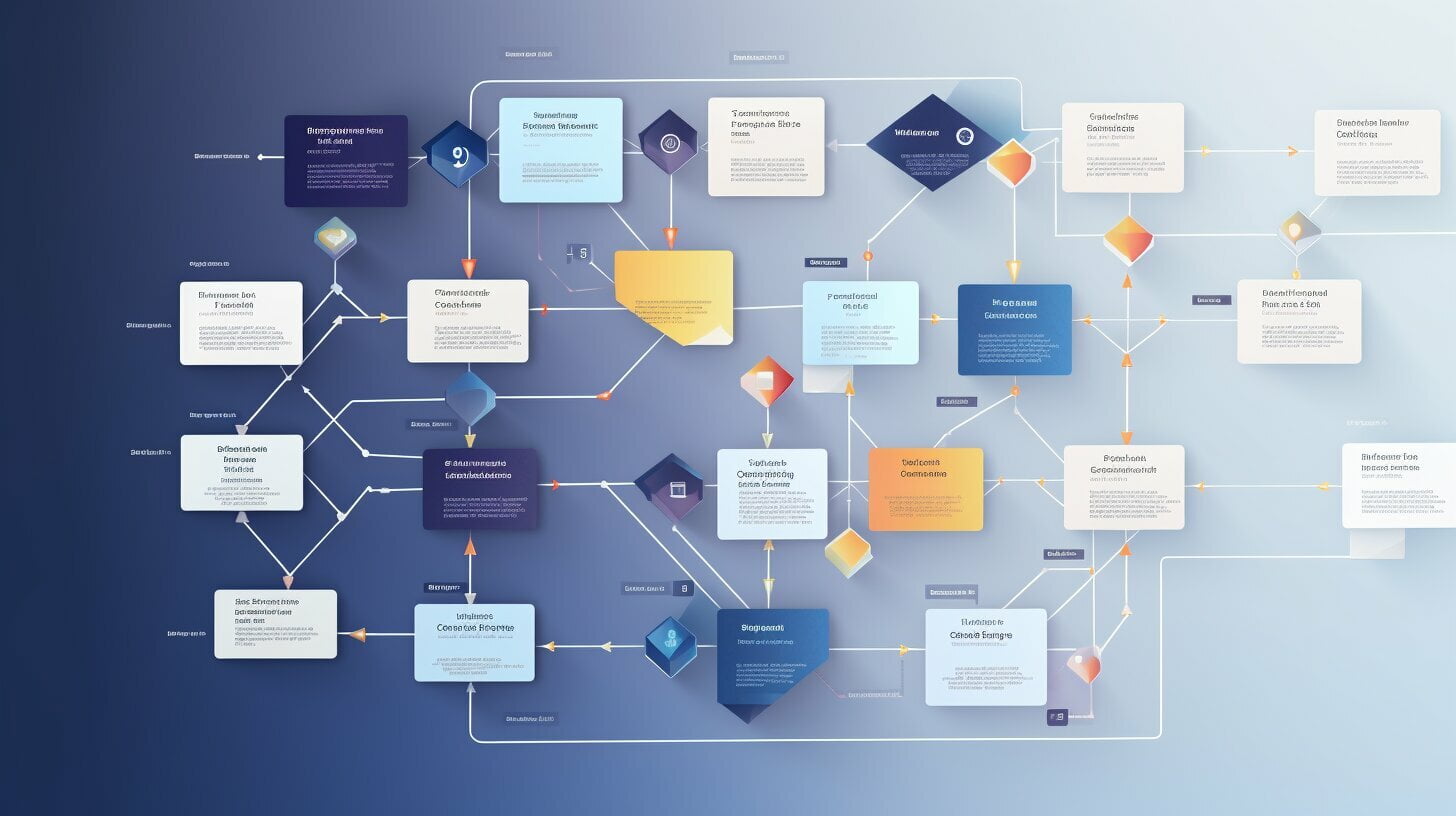Believe it or not, to conduct a business process review shouldn’t have to be as painful as a root canal.
In fact, it can be downright fun! Okay, maybe we’re exaggerating a bit, but it doesn’t have to be a daunting task.
With these easy steps, you’ll unravel inefficiencies and improve your organisation’s processes in no time.
So, buckle up and get ready for some process improvement science!
Table of Contents
ToggleKey Takeaways:
- Conducting a business process review will help you improve your organisation’s efficiency and effectiveness.
- The first step is to define the objectives and scope of the review.
- Gather information and document processes to get a clear understanding of the existing workflows.
- Identify areas for improvement and develop and implement process improvement strategies.
- Monitor and reassess your processes to ensure ongoing improvement and success.
Step 1: Define the Objectives and Scope of the Review.
The first step is to define your objectives and determine the scope of the review. Don’t be daunted, it’s easier than it sounds.
Start by asking yourself, what are you hoping to achieve with this review? Is there a specific area or process you want to assess?
Once you have a clear idea of your objectives, you can determine the scope of the review. This will help you focus your efforts and ensure you’re not wasting valuable time and resources.
For example, if you’re looking to improve your sales processes, you’ll want to focus on that area specifically.
If you’re looking for a more comprehensive review, you may want to assess all of your key processes.
Remember, a clearly defined objective and scope will provide a framework for the entire review process, making it easier to manage and prioritize.

Expert Tip: Be specific when defining your objectives. Vague goals will make it difficult to determine success and track progress.
Step 2: Gather Information and Document Processes
Now it’s time to delve deeper into your processes.
Don your detective hat and gather data using process mapping techniques. Think of it as mapping out a treasure trail, except the treasure is process optimization and the trail is your current workflow.
Document everything in sight: who’s involved, what they do, and how they do it. Keep it organized, add post-it notes if you like, and remember to take deep breaths if things get overwhelming.
If you’re feeling brave, consider using a Business Process Management (BPM) tool to streamline the process mapping.
You’ll save time and trees, and the environment (and your colleagues) will thank you.
Once you’ve documented your processes, it’s time to evaluate their effectiveness. Be on the lookout for bottlenecks, redundancies, and ineffective steps.
You can use a process review checklist or your own custom process analysis methods to identify inefficiencies.

Pro tip: Don’t be afraid to ask questions. The more you understand the processes, the better your chances of optimizing them.
Step 3: Analyze and Evaluate Process Effectiveness
Now it’s time to get down to the nitty-gritty and analyze the effectiveness of your processes.
This step involves identifying key performance indicators (KPIs) that align with your objectives and measuring the current process performance against these benchmarks.
Don’t worry, we won’t bore you with the technical details of process analysis steps, but it’s essential to evaluate the effectiveness of your processes to identify opportunities for improvement.
This will help you determine whether the current processes meet your objectives and deliver the desired outcomes.

Pro tip: Remember, the goal is not to achieve perfection, but rather to strive for continuous improvement. So, don’t be too hard on yourself when analyzing process effectiveness.
Effective process review techniques can help you identify strengths and weaknesses in the processes and pinpoint areas that require improvement. This step is crucial in ensuring that the improvements you make are targeted and effective.
SEE ALSO
- The Secret to Conducting a Successful Business Process Review
- Business Process Review Productivity: Steps To Maximize It
- 3 Signs You Need a Business Process Review ASAP
Step 4: Identify Process Inefficiencies and Opportunities for Improvement.
Alright, it’s time to get down to the nitty-gritty of process improvement!
You’ve got all the data you need, and now you need to sift through it to identify any inefficiencies and opportunities for optimization.
1.First off, take a long hard look at the processes you’ve been evaluating. Are there any steps that seem redundant, unnecessary, or just plain time-wasting?
Mark these down as potential areas for improvement.
2. Next, look for bottlenecks in your workflows. Are there areas where the process slows down or gets bogged down? These can be major areas for improvement.
3.Finally, look at how different parts of your process fit together. Are there any areas where hand-offs between departments or team members are causing problems?
These can be particularly tricky to diagnose, but if you can identify them, you can usually find ways to streamline the process.

Step 5: Develop and Implement Process Improvement Strategies.
Now that you have identified the inefficiencies and bottlenecks in your processes, it’s time to get down to business and develop some improvement strategies.
You wouldn’t want your business processes to be as effective as a horse on roller-skates, would you? Of course not.
Collaborate with your team members and stakeholders to brainstorm ideas. It’s always good to get multiple perspectives on the table so that you can identify the best possible solution.
Pro Tip: Bring some snacks and refreshments to the brainstorming session to keep everyone’s creative juices flowing.
Once you have identified the best solutions, create an action plan and set realistic goals for implementing the improvements.
Make sure that you communicate the changes with everyone involved in the process.
You wouldn’t want someone to be surprised when they suddenly have to start roller-skating, now would you?
Implement the changes and monitor their impact. Make sure that they are effective and sustainable. After all, you wouldn’t want to make changes that are only effective for a short while, would you?

“Continuous improvement is better than delayed perfection.” – Mark Twain
Remember, the key to success is continuous improvement. Keep monitoring and reassessing your processes to ensure ongoing improvement and success.
And if roller-skating horses ever become more effective, well, then it might be time to review your processes again!
Conclusion
Congratulations, you’ve made it to the end of the business process review! You’ve followed the 6 easy steps and are now equipped with the knowledge and tools to optimize your organization’s efficiency and effectiveness.
Continuous Improvement
Remember, the key to success is continuous improvement. Your business processes will constantly evolve and change, and it’s important to regularly reassess and optimize them to stay ahead of the game.
Keep monitoring your metrics and KPIs, and don’t be afraid to make changes when necessary.
Make it Fun
While conducting a business process review may not sound like the most exciting task, it can be a great opportunity to brainstorm new ideas and strategies with your team members.
Try to make it fun by incorporating team-building exercises or offering incentives for innovative solutions.
The Final Touch
So, go ahead and put your newfound process improvement techniques to the test.
Remember, every step counts towards optimizing your business, so take the first step today!
FAQ
What is a business process review?
A business process review is a systematic evaluation of an organization’s processes to identify inefficiencies and areas for improvement.
How can a business process review benefit my organization?
A business process review can help streamline workflows, eliminate waste, and enhance efficiency and productivity within your organization.
What are the steps involved in conducting a business process review?
There are essential steps in conducting a business process review, including defining objectives, gathering information, analyzing process effectiveness, identifying inefficiencies, developing improvement strategies, and implementing changes.
How long does a business process review typically take?
The duration of a business process review can vary depending on the complexity of your organization’s processes. It is best to allocate sufficient time to ensure a thorough evaluation.
Who should be involved in a business process review?
It is best to involve stakeholders, department heads, and team members who are directly involved in the processes being reviewed. Collaboration and input from various perspectives can lead to more effective improvements.
How often should a business process review be conducted?
It is recommended to conduct regular business process reviews to ensure continuous improvement. The frequency may vary based on the nature of your organization, but an annual review is a good starting point.
Can a business process review help in identifying cost-saving opportunities?
Yes, a business process review can identify cost-saving opportunities by eliminating redundant steps, optimizing workflows, and reducing waste within the processes.
Should I involve external consultants for a business process review?
Involving external consultants can provide an objective perspective and specialized expertise in conducting a business process review. However, it is not always necessary, and it depends on the specific needs and resources of your organization.






